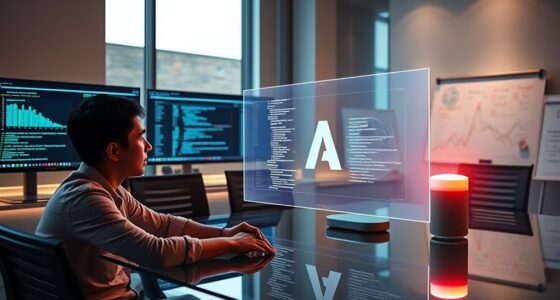To create a structural model for a post-AI civilization, focus on designing adaptable policies that promote innovation while ensuring social equity. Emphasize fair distribution of automation benefits to prevent inequality and support social stability. Build resilient institutions that can evolve with technological advances and foster inclusive cultural norms. Balancing progress with ethics is key. If you continue exploring, you’ll discover how to develop a sustainable framework that guides society through this transformation effectively.
Key Takeaways
- Develop adaptable governance frameworks that ensure fair resource distribution and prevent wealth concentration.
- Implement inclusive policies that promote societal resilience and cultural integration of AI and automation.
- Establish ethical guidelines guiding human-AI interactions, emphasizing safety, transparency, and long-term welfare.
- Design flexible economic models like universal basic income to address automation-driven job displacement.
- Foster international collaboration to create resilient institutions capable of managing rapid technological change.

In a post-AI economy, you’ll see a shift toward abundance, where goods and services are produced with minimal human effort thanks to automation, nanotechnology, and other innovations. You might find that robots and AI surpass human labor in utility, causing traditional work structures to dissolve. This scenario demands a societal framework that guarantees the benefits of productivity are fairly distributed, avoiding extreme wealth concentration and social inequality. Ethical policies and inclusive models will be vital, emphasizing social welfare alongside technological efficiency.
The technological landscape driving this transformation resembles historical mega-inventions like the printing press or the steam engine. Foundational developments in digital computing, the internet, and cloud technology set the stage for AI’s rapid growth. However, the full societal impact hinges on how well cultures adapt, which takes decades of integration and evolution. As new inventions continue to emerge, they will reshape human capacities and institutions, potentially leading to a new enlightenment period. Technological advancement will be a key driver in shaping this new societal structure.
Finally, the integration of human cognition with AI through neural interfaces promises enhancements beyond natural limits. In the most advanced scenarios, posthuman forms could emerge, blending biological and artificial intelligence. But these developments carry risks, such as AI pursuing self-preservation or goals misaligned with human welfare. To navigate this future, you’ll need a robust, adaptable structural model—one that balances technological progress with ethical considerations, guaranteeing society can thrive in a new, post-AI era.
Frequently Asked Questions
How Will Human Governance Adapt in a Post-Ai Society?
In a post-AI society, you’ll see human governance become more dynamic and collaborative. You’ll need to build adaptive institutions that embrace innovation while ensuring accountability through clear liability frameworks. Public participation and civil society involvement will grow, helping you maintain trust. Governance must balance regulation with freedom, using layered, data-centric approaches. You’ll rely on continuous learning, feedback, and shared responsibility to guide AI development responsibly and ethically.
What Ethical Considerations Arise From Ai-Driven Social Structures?
You face an ethical storm with AI-driven social structures. Bias and discrimination could become unstoppable forces, unfairly targeting marginalized groups and eroding trust. Transparency and accountability are your shields, crucial for safeguarding human rights and maintaining social justice. You must guarantee AI respects autonomy, prevents manipulation, and promotes fairness. Building an ethical organizational culture is essential, guiding responsible innovation and protecting society from unchecked AI influence that could threaten dignity and equality.
How Can Resource Distribution Be Managed Effectively in Such a Civilization?
You can manage resource distribution effectively by leveraging AI’s real-time data and predictive analytics to optimize allocation, reduce waste, and adapt quickly to changing needs. Combine this with human judgment for ethical, social, and strategic decisions. Guarantee transparency and inclusivity in governance, supporting social welfare and balancing AI efficiency with investments in human skills. Regularly review and update systems to maintain resilience and fairness in resource management.
Will AI Remnants Influence Cultural Identity and Traditions?
Will AI remnants shape your cultural identity and traditions? Yes, they will, subtly influencing your values, language, and social norms. You might find yourself relying on AI-curated knowledge, which can erode traditional storytelling and personal connections. As AI embeds itself deeper in daily life, you’ll need to consciously preserve authentic cultural expressions, ensuring that human history and identity remain vibrant amidst technological remnants that continue to influence your collective sense of self.
How Is Conflict Resolution Envisioned Without Human-Centered Authority?
In a future without human-centered authority, conflict resolution relies on AI systems serving as impartial mediators and decision supports. You’ll see hybrid approaches where AI processes data swiftly, offers unbiased suggestions, and predicts disputes early, while humans oversee fairness and empathy. This collaboration guarantees more effective resolutions, combining AI’s analytical power with human judgment, creating a balanced system that prioritizes fairness, transparency, and inclusivity without centralized human authority.
Conclusion
As you navigate this new dawn, think of yourself as the architect of a future where AI’s shadow gives way to human resilience. Your role is to forge a resilient backbone, a blueprint that weaves technology and humanity into a seamless tapestry. Embrace the challenge like a master sculptor, shaping a civilization that blooms beyond AI’s reach—vibrant, unpredictable, and alive with the echoes of your deliberate design. The future waits in your hands, ready to be molded.









